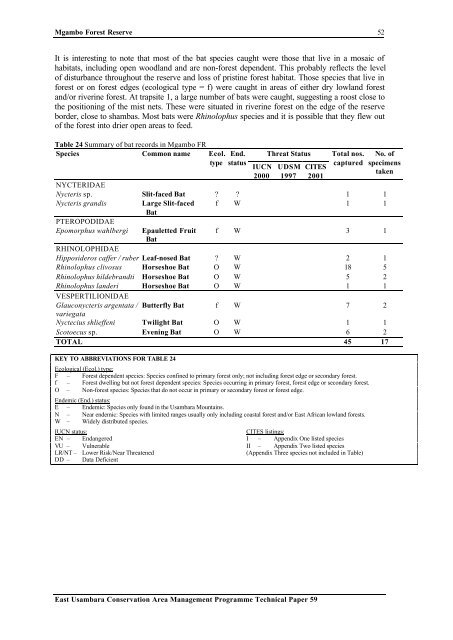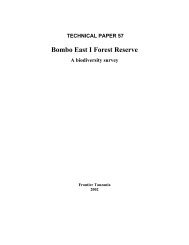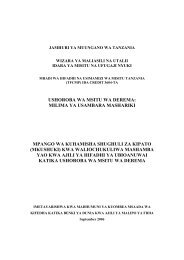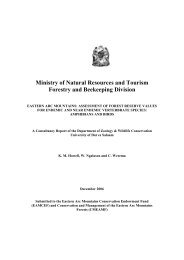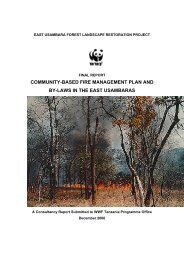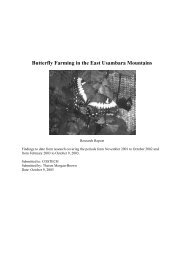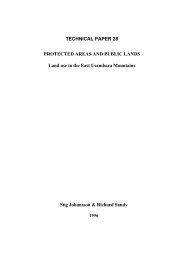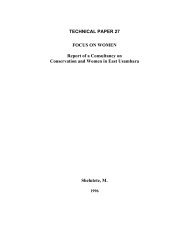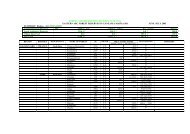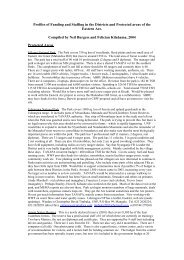Mgambo Forest Reserve: A biodiversity survey. - Eastern Arc ...
Mgambo Forest Reserve: A biodiversity survey. - Eastern Arc ...
Mgambo Forest Reserve: A biodiversity survey. - Eastern Arc ...
You also want an ePaper? Increase the reach of your titles
YUMPU automatically turns print PDFs into web optimized ePapers that Google loves.
<strong>Mgambo</strong> <strong>Forest</strong> <strong>Reserve</strong><br />
It is interesting to note that most of the bat species caught were those that live in a mosaic of<br />
habitats, including open woodland and are non-forest dependent. This probably reflects the level<br />
of disturbance throughout the reserve and loss of pristine forest habitat. Those species that live in<br />
forest or on forest edges (ecological type = f) were caught in areas of either dry lowland forest<br />
and/or riverine forest. At trapsite 1, a large number of bats were caught, suggesting a roost close to<br />
the positioning of the mist nets. These were situated in riverine forest on the edge of the reserve<br />
border, close to shambas. Most bats were Rhinolophus species and it is possible that they flew out<br />
of the forest into drier open areas to feed.<br />
Table 24 Summary of bat records in <strong>Mgambo</strong> FR<br />
Species Common name Ecol.<br />
type<br />
End.<br />
status<br />
IUCN<br />
2000<br />
Threat Status<br />
UDSM<br />
1997<br />
East Usambara Conservation Area Management Programme Technical Paper 59<br />
CITES<br />
2001<br />
Total nos.<br />
captured<br />
52<br />
No. of<br />
specimens<br />
taken<br />
NYCTERIDAE<br />
Nycteris sp. Slit-faced Bat ? ? 1 1<br />
Nycteris grandis<br />
PTEROPODIDAE<br />
Large Slit-faced<br />
Bat<br />
f W 1 1<br />
Epomorphus wahlbergi<br />
RHINOLOPHIDAE<br />
Epauletted Fruit<br />
Bat<br />
f W 3 1<br />
Hipposideros caffer / ruber Leaf-nosed Bat ? W 2 1<br />
Rhinolophus clivosus Horseshoe Bat O W 18 5<br />
Rhinolophus hildebrandti Horseshoe Bat O W 5 2<br />
Rhinolophus landeri<br />
VESPERTILIONIDAE<br />
Horseshoe Bat O W 1 1<br />
Glauconycteris argentata /<br />
variegata<br />
Butterfly Bat f W 7 2<br />
Nyctecius shlieffeni Twilight Bat O W 1 1<br />
Scotoecus sp. Evening Bat O W 6 2<br />
TOTAL 45 17<br />
KEY TO ABBREVIATIONS FOR TABLE 24<br />
Ecological (Ecol.) type:<br />
F – <strong>Forest</strong> dependent species: Species confined to primary forest only; not including forest edge or secondary forest.<br />
f – <strong>Forest</strong> dwelling but not forest dependent species: Species occurring in primary forest, forest edge or secondary forest.<br />
O – Non-forest species: Species that do not occur in primary or secondary forest or forest edge.<br />
Endemic (End.) status:<br />
E – Endemic: Species only found in the Usambara Mountains.<br />
N – Near endemic: Species with limited ranges usually only including coastal forest and/or East African lowland forests.<br />
W – Widely distributed species.<br />
IUCN status: CITES listings:<br />
EN – Endangered I – Appendix One listed species<br />
VU – Vulnerable II – Appendix Two listed species<br />
LR/NT – Lower Risk/Near Threatened (Appendix Three species not included in Table)<br />
DD – Data Deficient


